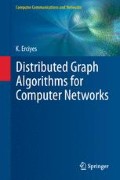Abstract
Topology control in ad hoc wireless networks aims to provide a sparser graph by preventing the use some of the existing communication links so that some of the neighbors of a node are excluded from its neighbor list deliberately, which would result in a simpler network graph. A hierarchical network structure is an effective way to organize a network comprising a large number of nodes. An efficient method of providing hierarchy and therefore scalability in ad hoc wireless networks is to group nodes of the network into clusters. Building such a hierarchy has many advantages including routing and load balancing. An efficient way of constructing a backbone and clusters is graph domination. In this chapter, we examine methods to construct sparse graphs, called local graphs, clustering, and the use of connected dominating sets for topology control.
Access this chapter
Tax calculation will be finalised at checkout
Purchases are for personal use only
References
Alzoubi KM, Wan P-J, Frieder O (2002) New distributed algorithm for connected dominating set in wireless ad hoc networks. In: Proc 35th Hawaii international conference on system sciences, Big Island, Hawaii, 2002
Alzoubi KM, Wan P-J, Frieder O (2002) Message-optimal connected dominating sets in mobile ad hoc networks. In: MOBIHOC, EPFL Lausanne, Switzerland, 2002
Amis AD, Prakash R, Vuong THP, Huynh DT (2000) Max–min D-cluster formation in wireless ad hoc networks. In: Proc IEEE INFO-COM, Tel Aviv, Israel, 2000
Anupama M, Sathyanarayana B (2011) Survey of cluster based routing protocols in mobile ad hoc networks. Int J Comput Theory Eng 3(6):806–815
Banerjee S, Khuller S (2000) A clustering scheme for hierarchical routing in wireless networks. Technical report CS-TR-4103, University of Maryland, College Park
Basagni S (1999) Distributed clustering for ad hoc networks. In: Proc internat sympos parallel algorithms, architectures and networks ISPAN’99, Perth, Australia, pp 310–315
Basagni S (1999) Distributed and mobility-adaptive clustering for multimedia support in multi-hop wireless networks. In: Proc IEEE VTC, September 1999
Cidon I, Mokryn O (1998) Propagation and leader election in multihop broadcast environment. In: Proc 12th int symp distr computing, pp 104–119
Cokuslu D, Erciyes K, Dagdeviren O (2006) A dominating set based clustering algorithm for mobile ad hoc networks. In: International Conference on Computational Science, vol 1, pp 571–578
Das B, Bharghavan V (1997) Routing in ad-hoc networks using minimum connected dominating sets. In: IEEE international conference on communications (ICC’97), vol 1, pp 376–380
Du DZ, Pardalos P (eds) (2004) Handbook of combinatorial optimization. Kluwer Academic, Dordrecht, pp 329–369
Erciyes K, Ozsoyeller D, Dagdeviren O (2008) Distributed algorithms to form cluster based spanning trees in wireless sensor networks. In: ICCS 2008. LNCS. Springer, Berlin, pp 519–528
Garey MR, Johnson DS (1979) Computers and intractability: a guide to the theory of NP-completeness. Freeman, New York
Gerla M, Tsai JTC (1995) Multicluster, mobile, multimedia radio network. Wirel Netw 1:255–265
Ghiasi S, Srivastava A, Yang X, Sarrafzadeh M (2002) Optimal energy aware clustering in sensor networks. Sensors 2(7):258–269
Guha S, Khuller S (1998) Approximation algorithms for connected dominating sets. Algorithmica 20(4):374–387
Kawadia V, Kumar PR (2003) Power control and clustering in ad hoc networks. In: Proc of IEEE INFOCOM 2003, vol 1, pp 459–469
Krishna P, Vaidya NH, Chatterjee M, Pradhan DK (1997) A cluster-based approach for routing in dynamic networks. Comput Commun Rev 49:49–64
Li L, Halpern JY, Bahl P, Wang Y, Wattenhofer R (2001) Analysis of cone-based distributed topology control algorithm for wireless multi-hop networks. In: Proc 20th annual ACM SIGACT-SIGOPS symposium on principles of distributed computing (PODC)
Li X-Y, Wan P-J, Wang Y, Frieder O (2002) Sparse power efficient topology for wireless networks. In: IEEE Hawaii international conference on system sciences (HICSS 2002)
Li L, Halpern JY, Bahl P, Wang Y-M, Wattenhofer R (2005) A conebased distributed topology-control algorithm for wireless multi-hop networks. IEEE/ACM Trans Netw 13(1):147–159
Lin CR, Gerla M (1997) Adaptive clustering for mobile wireless networks. IEEE J Sel Areas Commun 15(1):1265–1275
Liu JS, Lin CHR (2005) Energy-efficiency clustering protocol in wireless sensor networks. Ad Hoc Netw 3(3):371–388
Lukovszki T (1999) New results on geometric spanners and their applications. PhD thesis, University of Paderborn
Manousakis KS, Baras JS (2003) Clustering for transmission range control and connectivity assurance for self configured ad hoc networks. In: Proc of IEEE MILCOM 2003
Nocetti FG, Solano-González J, Stojmenovic I (2003) Connectivity based k-hop clustering in wireless networks. Telecommun Syst 22(1–4):205–220
Peleg D (2000) Distributed computing: a locality-sensitive approach. SIAM, Philadelphia. ISBN 0-89871-464-8
Rekhter Y, Li T (1995) A border gateway protocol 4. IETF RFC 1771
Wattenhofer W, Li L, Bahl P, Wang Y-M (2001) Distributed topology control for power efficient operation in multihop wireless ad hoc networks. In: Proc IEEE infocom
Wei D, Chan HA (2006) Clustering ad hoc networks: schemes and classifications. In: Sensor and ad hoc communications and networks (SECON 2006), vol 3, pp 920–926.
Yu J, Chong P (2005) A survey of clustering schemes for mobile ad hoc networks. IEEE Commun Surv Tutor 7(1):32–48
Author information
Authors and Affiliations
Rights and permissions
Copyright information
© 2013 Springer-Verlag London
About this chapter
Cite this chapter
Erciyes, K. (2013). Topology Control. In: Distributed Graph Algorithms for Computer Networks. Computer Communications and Networks. Springer, London. https://doi.org/10.1007/978-1-4471-5173-9_15
Download citation
DOI: https://doi.org/10.1007/978-1-4471-5173-9_15
Publisher Name: Springer, London
Print ISBN: 978-1-4471-5172-2
Online ISBN: 978-1-4471-5173-9
eBook Packages: Computer ScienceComputer Science (R0)

